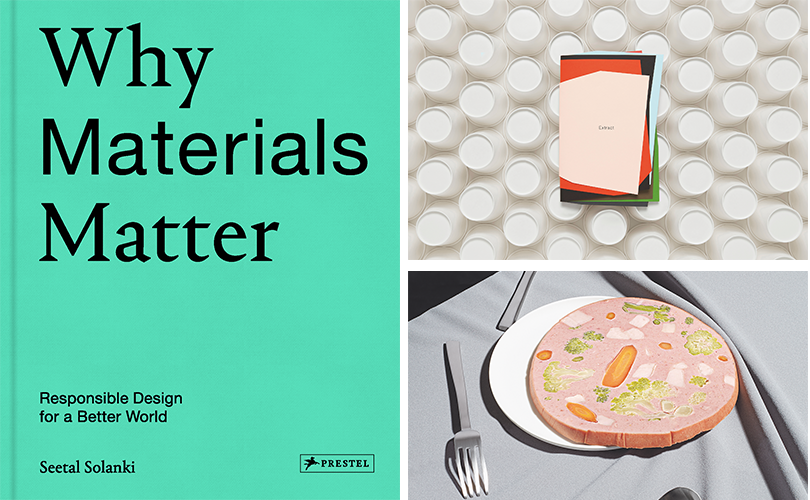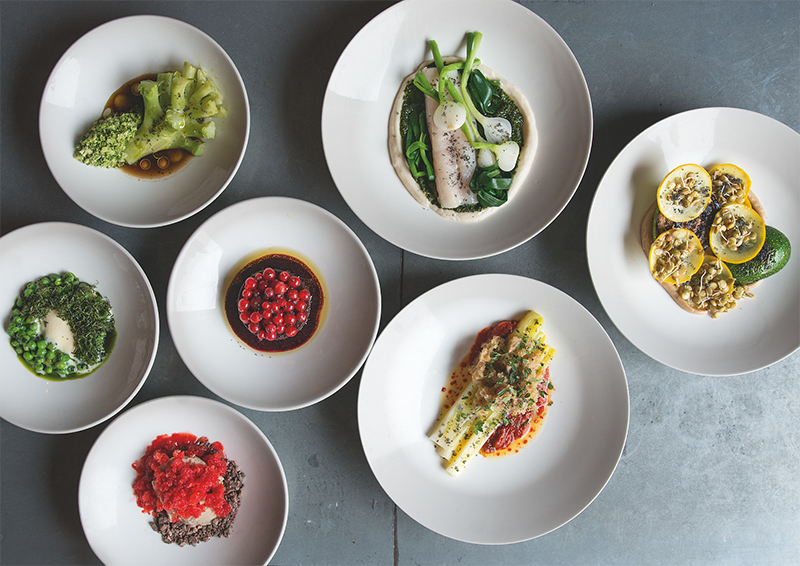
TOP RIGHT: G.F. Smith’s Extract paper collection is made entirely from post-consumer coffee cup waste. BOTTOM RIGHT: Carolien Niebling’s Sausage of the Future explores vegetable-based meat alternatives. All images are courtesy © Prestel
In her career as a textile designer, Seetal Solanki created prints for Alexander McQueen, color palettes for Nissan, and editorials for Alvar magazine. But having seen the enormous potential of new, ecologically-driven materials, and the enormous waste created by traditional ones, she decided to change the way we think about—and use—the stuff that surrounds us.
In 2015 Solanki founded the London-based research and design studio Ma-t-ter, where she counsels clients like Nike, the British Council and Ikea/Space 10 on how to find, consume and talk about responsible materials. Her recent book, Why Materials Matter, assembles cutting-edge projects by designers and artists around the globe. Jordan MacInnis caught up with her recently to talk about why it’s good to be materialistic.
Jordan MacInnis: You’ve said that material designers are often undervalued. Why do you think that is?
Seetal Solanki: I was always on a mission to understand what textile or material designers could do beyond fashion and interiors so I worked within architecture, automotive, lighting, events, digital. You name it I tried it.
All of these industries had a similar design process and materials often just got tacked on at the end. As a material designer, I should have been part of the whole process. Materials connect everything together in any kind of design; there’s not really anything you can create without them. It might have meant less waste and it would have been more efficient and effective. It was a really big frustration. That got me thinking, what if we did this differently? How can we create a more sustainable approach to design with materials as the catalyst?

LEFT: Fernando Laposse’s Totomoxtle uses heirloom corn husks to create a surfacing veneer RIGHT: Tino Seubert’s The Colour of Air captures air pollution to create a wearable dye. All images are courtesy © Prestel
JMI: The book focuses on the innovate reuse of consumer and industrial waste: coffee cups, leather offcuts and air pollution. But you chose not to use the word sustainable.
SS: I really love the meaning of the word sustainable but it’s become a marketing term. It’s been misinterpreted and that misinterpretation has made people feel helpless. Plus there’s the fact that the word sustainable doesn’t really exist in Eastern countries. Using the word responsible means that you have the responsibility to do something or that you’re responsible for something. Sustainable makes it sound like it’s somebody else’s problem.
JMI: Last month the UN released a report stating that the natural world is experiencing a precipitous decline. What does that mean for materials?
SS: There’s a really great quote by Philip Ross from MycoWorks, a company that uses mycelium, a vegetable-based product, to make things like leather and foam. He says that there isn’t so much a crisis of materials but of how we think about them, organize them and use them. Materials aren’t scarce because we are dealing with so much waste and as a resource that waste is so abundant. As the book shows, designers, artists, scientists and researchers are responding to this waste and turning it into products.
One material can address multiple issues. Carbon can be captured from the air and turned into an ink or a dye. The Mexican designer Fernando Laposse is reviving an indigenous corn crop which creates a trade, an economy and a year-round income for farmers. A versatile material like algae or seaweed can be a fuel, a dye, a textile, thatching for housing, insulation, and food.

Silo is the UK’s first zero waste restaurant. All images are courtesy © Prestel
JMI: What’s one thing everyone should know about the material world?
SS: Everybody thinks every material should be available all the time and produced at a huge scale and that shouldn’t be the case. It shouldn’t be because then we’ll end up in a plastic epidemic again. I think the analogy of food and materials really comes in to play here. We are very aware of where our food comes from for example: How many miles has it traveled? Is it seasonal? How abundant is it? We need to be more mindful of where other things come from.
The journalist George Monbiot talks about the fact that while we are often told we are materialistic, we are in fact not materialistic enough. He says we have a disrespect for materials; we use them quickly and carelessly. That's exactly where we’re at as a planet and as a society. It’s our job as material designers to tackle that.
